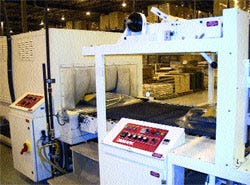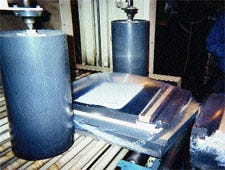March 11, 2015

The need for speed is pervasive at Canada's Belbois, Ltd. Recently, the manufacturer of upscale ready-to-assemble (RTA) home entertainment furniture shepherded two new products through the design and manufacturing cycle–from pen to box–in just four weeks' time.
|
Weighing as much as 300 lb, larger furniture kits are wrapped in thick PET film before withstanding a long shrink period inside the heat tunnel. |
According to Roman Trusiak, vp of production for Belbois, part of the secret behind such an accomplishment is an outstanding design team. Another key factor is the company's well-planned end-of-the-line workflow that includes a flexible shrink-wrapping system from Damark Packaging, Inc.
Installing the Damark equipment allowed Belbois to significantly increase the pace of its packaging line. "We have been able to double our productivity to ten or twelve units per minute with the Damark line compared to the other lines," says Trusiak.
Stylish fit
The privately held Belbois, Laval, QC, (French for "beautiful wood") was founded in 1978 as a joint venture with Hitachi to support cabinet production for television sets sold in North America. In the late '80s, a private investor bought out Hitachi's share, and Belbois broadened its line to include furniture for TVs and stereos from other major electronics manufacturers. The company has also started to sell audio and video gear direct to retailers in the U.S.
What sets Belbois apart is that its stands and cabinets are made to marry a specific unit, rather than to a generic box, PD is told. A custom match, right down to the finish, introduces an element of panache to an industry that has typically emphasized function over style.
Along with style, Belbois furniture kits are known for their ease of assembly. "A lot of flat-pack furniture does not fit together well," Trusiak states. "Our instruction sheets are well-illustrated, and our packages are complete. We actually get letters from customers congratulating us on a stand well-built."
The good fit is the result not only of precise design and manufacturing standards, but also of a packaging format that keeps as many as 30 different parts from going astray. Shrink-wrap machines receive kits before manual insertion into a paperboard shipping container sized to match the dimensions of the largest component it houses. "The classic problem with RTA products is that if a part–even a bolt or a screw–isn't there, the furniture is not functional," Trusiak informs.
Shrink wrapping is proving to be the ideal medium for Belbois to keep its kits intact and protect temperature-sensitive wood components, eliminating the possibility of swelling or shrinking. The company ships to 17 countries around the globe, including such hot spots as Mexico and Saudi Arabia, where heat and humidity could affect product quality. Trusiak adds, "Film has reduced our packaging problems."
Packaging sets the pace
Unlike many factory environments, where production moves in an integral stream from raw material to final packaging, the workflow at Belbois is segmented into two distinct operations. One plant manufactures the components, and then they are moved to an adjacent facility where packaging and storage are done.
The diversity of product models–and the individual parts within them–prevent automated kit assembly. Instead, workers operate next to skids or bins of components at various points on both sides of the 80-ft-long conveyor that feeds into the in-line sleeve wrapper. Parts are organized according to size, progressing from the largest at the beginning of the line to the smallest just before the Damark machine. Each worker stacks one or more pieces on the growing pile, building the kit from the bottom up in a pyramid pattern.
The sleeve-wrapping system outperforms the original specifications, achieving speeds of 12 pieces/min, twice the original capacity of the line. Although a bit slower, the largest flat-packs still move through at eight and 10 cycles/min for 48- and 36-in.-long kits, respectively.
Quick-change artists
Belbois might produce as many as 80 different furniture models in a month. To accommodate different-sized kits that run in batches of 500 to 1,000 units at a time, the packaging line manages changeovers quite easily–virtually instantaneously, according to the president of Damark Packaging, Inc., Bill Steel. The flexibility derives from the use of photocells to trigger variable machine functions, such as film feed, seal location, and time spent under the blower, PD is informed.
"Photocells allow the film feed to operate on-demand, so instead of metering out a predetermined amount of film, the machine senses how much is necessary to cover the package coming through the system," Steel explains.
"We can actually put a forty-eight-inch-long package on the line right after a thirty-six-inch-long package, and it will make no difference because of the photocells," remarks Trusiak.
While line speed can be increased or reduced, the biggest adjustment Belbois makes is a switch between polyethylene film sizes. At most, the kit-maker uses just three different film sizes, either 28, 36 or 40 in. wide. The PE film is proprietary.
Another important aspect of the packaging line is the shrink tunnel. The larger furniture kits can weigh as much as 300 lb. The heavier the kit, the thicker the PE film in which it needs to be wrapped. At the same time, the thicker the plastic, the longer the package must stay in the heat chamber for film shrinkage. This, in turn, can slow the line down.
With speed a priority, Damark resolves this potential bottleneck by adding two extra zones to the tunnel, prolonging the heating cycle without impacting the pace of production. According to Steel, the resulting quad-zone tunnel does not represent a radical design change. "The key factors governing tunnel performance are air circulation and heat output and control," he says. These functions are delivered by the blowers and heaters, respectively. Damark uses the same type of heavy-duty 1600-W heaters since it began manufacturing 20 years ago.
|
An extruded aluminum, Teflon-coated sealing head creates seams at the top and bottom of the package. An optional product-side closure system, located in the shrink tunnel, takes up excess film to assure a tight fit. |
Damark shrink tunnels can contain anywhere from two heaters up to a maximum of 60, as on the Belbois quad-zone model, where the 4-ft-long units are doubled over in clusters of 15 per zone. Typical operating temperature inside the tunnel is about 380 deg F, but the capacity is far higher, approaching 550 deg F. As for air flow, Damark uses custom-engineered turbo blowers that produce twice the air volume as a regular blower with just half the number of revolutions.
Another aspect of the tunnel Belbois was initially concerned about is its use of rollers–as opposed to a belt–to propel packages through the heat-shrink process. Trusiak's original apprehension stemmed from his experience with a different manufacturer's machine, which saw the rollers bending under repeated use. After visiting another Damark installation, he realized that the 1-in.-dia rollers of 16-gauge steel covered with silicone tubing and attached to a roller-bearing chain by 3/16-in. pins at either end, was sturdy enough to support his heavy furniture kits. What had caused the previous stress was workers' attempts to push packages through to make the line move more quickly, which would not be an issue, given the speed of the new line.
Sealing area
The Damark sleeve wrapper envelopes each incoming kit in plastic by marrying film dispensed from two separate but identical rolls in stations over and under the machine. The extruded aluminum, Teflon®-coated sealing head makes seams at the top and bottom of the kit, at right angles to the line, leaving the sides open like a sleeve.
To fully encase the kit in plastic, Damark utilizes an optional product-side closure system in the shrink tunnel. The side closure also takes up excess film to assure a tight fit.
After heat is applied in the chamber, the shrink film fills with air. Cooling fans at the end of the tunnel cause the film to contract, while air escapes through minute holes in the pre-perforated film. The machine can also perforate film. Cooling continues even as the kit is cartoned, giving the film a skin-tight fit, almost like a blister-pack, to eliminate the possibility of any parts moving in transit.
As the finished kits exit the tunnel, workers erect the preglued bottom halves of the shipping carton. The corrugated containers vary in gauge from 200#-test, singlewall to 200#-test doublewall, depending on the weight of the contents. Workers deposit open boxes, one by one, on the line to meet the wrapped products that slide easily into place. The corrugated cases are supplied by Standard Paper Box Machine Co.
Workers then put lids on the cartons to close them, after which they pass through a semi-automatic strapping system, supplied by Samuel Strapping Systems. The cartons are subsequently biscuit-stacked on pallets in lots of anywhere from eight to 45 units, and then stretch-wrapped.
Gearing up
Trusiak anticipates an increase in production output that will prompt the installation of a fourth packaging line. With shrink-wrapping systems from two other manufacturers besides Damark, he has had plenty of opportunity to assess relative performance.
|
Wrapped kits exit the shrink tunnel, and workers slide them into place in open shipping cases. The skin-tight shrink film eliminates moving parts and protects product. |
"Our other lines still have problems with the ovens, but we have had no problems with our Damark system," he says.
"We'll be writing specifications for another line in the next year, and obviously we're going to be back knocking on Damark's door. By far they've outperformed the competition," he concludes.
More information is available:
Shrink wrapper: Damark Shrink Packaging Systems, 416/609-8011. Circle No. 228.
Corrugated cases: Standard Paper Box Machine Co., Inc., 800/367-8755. Circle No. 229.
Strapper: Samuel Strapping Systems, 800/323-4424. Circle No. 230.
About the Author(s)
You May Also Like





